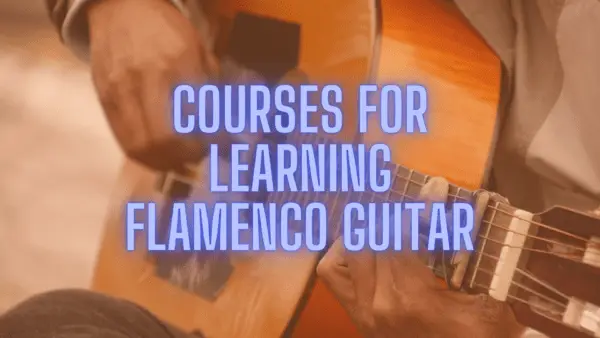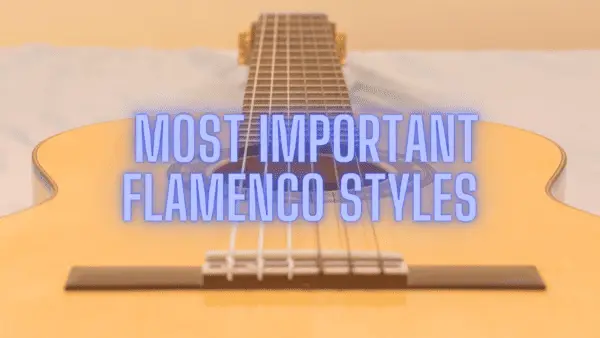
Best courses for learning how to play the flamenco guitar
Do you want to learn to play flamenco guitar? We are going to show you the best courses to learn how to play. Let’s take a look.

Do you want to know the best easy Flamenco guitar songs? A tradition deeply embedded in Spanish culture offers a captivating journey for musicians. Its rich history, characterized by emotive melodies and intricate techniques, provides a unique avenue for artistic expression.
For beginners, navigating the world of flamenco guitar may seem daunting due to its technical demands. However, approaching this style methodically can make the learning process more accessible and enjoyable.
One essential aspect for beginners is to start with foundational techniques. These include mastering basic strumming patterns, fingerpicking techniques, and chord progressions commonly found in flamenco music. By focusing on these fundamental skills, beginners can gradually build the necessary dexterity and coordination required for more advanced flamenco guitar playing.
Additionally, it’s crucial for beginners to develop a strong sense of rhythm, as flamenco music is known for its intricate rhythmic patterns. Practicing with a metronome or drum machine can help beginners internalize flamenco rhythms such as the compás, providing a solid foundation for future exploration.
Another valuable approach for beginners is to study the structure and form of flamenco music. Understanding the traditional song structures and improvisational elements commonly found in flamenco compositions can provide insights into how pieces are constructed and interpreted.
Furthermore, seeking guidance from experienced flamenco guitarists or instructional resources tailored for beginners can be invaluable. Online tutorials, instructional books, and local flamenco guitar classes offer structured learning environments and personalized feedback to support beginners on their journey.
Lastly, cultivating patience and perseverance is key for beginners venturing into flamenco guitar. Like any musical style, mastering flamenco guitar takes time, dedication, and practice. Embracing the process and celebrating small victories along the way can keep beginners motivated and inspired on their path to proficiency.
By approaching flamenco guitar with a systematic and patient mindset, beginners can gradually unlock its beauty and complexity, paving the way for a rewarding musical journey filled with passion and discovery.
As beginners progress in their flamenco guitar journey, it’s essential to gradually introduce more advanced techniques and concepts. Building upon the foundational skills, beginners can begin to explore the following aspects:
Advanced Techniques: Once comfortable with basic strumming patterns and chord progressions, beginners can expand their repertoire of techniques. This may include mastering flamenco-specific techniques such as rasgueado (rapid strumming with the fingers), picado (fast picking with the fingers), and alzapúa (thumb technique). Regular practice and focused exercises can help beginners develop fluency and control in these techniques.
Understanding Palos: Flamenco music encompasses various styles known as palos, each with its own unique characteristics and rhythmic patterns. As beginners advance, they can delve deeper into different palos, exploring their distinct rhythms, melodies, and emotional qualities. Studying the traditional forms of bulerías, soleá, tangos, and seguiriyas, among others, allows beginners to broaden their musical vocabulary and deepen their understanding of flamenco music.
Melodic Exploration: While flamenco guitar is known for its rhythmic complexity, it also offers opportunities for melodic expression. Beginners can experiment with melodic variations, embellishments, and improvisation within the framework of traditional flamenco forms. Developing a repertoire of melodic motifs and phrases allows beginners to add depth and nuance to their playing, enhancing their musicality and creativity.
Accompaniment and Ensemble Playing: Flamenco guitar often serves as an accompaniment to singing, dancing, and other instruments in ensemble settings. As beginners progress, they can explore the role of the guitar within the context of flamenco ensembles, learning to support and interact with other musicians while maintaining the rhythmic and harmonic integrity of the music. Collaborating with singers, percussionists, and dancers provides valuable experience in ensemble playing and enhances musical communication skills.
Performance and Interpretation: Ultimately, the goal of learning flamenco guitar is to express oneself authentically and passionately through music. As beginners gain confidence and proficiency, they can focus on refining their performance skills and developing their unique artistic voice. Paying attention to dynamics, phrasing, and expression allows beginners to convey emotion and tell a story through their playing, captivating audiences with the power and beauty of flamenco music.
By embracing a holistic approach to learning flamenco guitar and incorporating these advanced elements into their practice routine, beginners can continue to grow and evolve as musicians, unlocking new levels of artistry and expression in their journey through the captivating realm of flamenco music.
Overview: Malagueña stands as a classic flamenco piece frequently performed as a solo guitar composition. Its simplicity makes it an ideal starting point for beginners.
Features:
Overall, while Malagueña serves as an accessible entry point for beginners, its rich cultural heritage and technical nuances offer endless opportunities for growth and exploration for intermediate and advanced players alike.
Overview: Composed by the legendary guitarist Paco de Lucia, Entre Dos Aguas offers a simplified version suitable for beginners.
Features:
Overall, Entre Dos Aguas serves as a compelling introduction to Paco de Lucía’s musical legacy and the art of flamenco guitar. While offering a simplified version for beginners, it presents opportunities for growth and exploration, making it a valuable addition to any guitarist’s repertoire.
Overview: Soleares, a traditional flamenco song often performed as a solo guitar piece, introduces beginners to fundamental flamenco techniques.
Features:
Overview: Granada, a classic Spanish song adapted for flamenco guitar, provides a gateway to the distinct Spanish guitar sound.
Features:
Overview: Bulerias, a fast-paced flamenco style often associated with dance, offers simplified versions suitable for beginners.
Features:
These five easy flamenco guitar songs serve as stepping stones for beginners venturing into the captivating realm of flamenco music. While simplistic in nature, they retain the beauty and expressiveness inherent in flamenco, allowing beginners to develop their skills and technique gradually. As proficiency grows, aspiring flamenco guitarists can explore more complex pieces and techniques. With dedication and practice, mastery of flamenco guitar is within reach, enabling enthusiasts to share its passion and allure with the world.
Historical Context: Providing a brief overview of the historical and cultural significance of flamenco music can deepen beginners’ appreciation for the art form. Explaining flamenco’s roots in the diverse cultural heritage of Andalusia, Spain, and its evolution over centuries through influences from various cultures such as Arabic, Jewish, and Romani, can enrich their understanding of its depth and complexity.
Importance of Technique: Emphasizing the importance of technique in flamenco guitar playing can motivate beginners to focus on refining their skills. Discussing key techniques such as rasgueado, picado, alzapúa, and golpe can give beginners a roadmap for their learning journey and encourage them to seek guidance from experienced teachers or resources.
Listening and Analysis: Encouraging beginners to listen to recordings of accomplished flamenco guitarists and analyze their playing can inspire them to aspire to higher levels of performance. By studying the nuances of rhythm, melody, and expression in professional recordings, beginners can gain insights into the artistry and craftsmanship required to master flamenco guitar.
Cultural Immersion: Immersing beginners in the cultural context of flamenco through exposure to related art forms such as flamenco dance, singing, and poetry can deepen their connection to the music. Encouraging them to attend live flamenco performances, participate in workshops, or explore flamenco documentaries and literature can enrich their understanding of flamenco’s significance as a form of cultural expression and identity.
Community and Collaboration: Fostering a sense of community and collaboration among beginners by organizing group lessons, jam sessions, or online forums can create a supportive environment for learning and growth. By sharing their experiences, challenges, and achievements with fellow enthusiasts, beginners can build confidence, camaraderie, and a sense of belonging within the flamenco guitar community.
By incorporating these additional elements into their learning journey, beginners can enhance their understanding, appreciation, and enjoyment of flamenco guitar music, paving the way for a fulfilling and rewarding pursuit of mastery in this captivating art form.
CEO de la empresa

Do you want to learn to play flamenco guitar? We are going to show you the best courses to learn how to play. Let’s take a look.

Which are the most important flamenco styles?

What are the differences between a flamenco guitar and a classical guitar? Let’s have a look

There is a great variety of guitars and within each type of guitar, there are different types. A LesPaul guitar is not the same as a Fender guitar, but what are the differences between a classical guitar and a flamenco guitar? Let’s take a look!